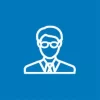In Switzerland, home-based broadband Internet is delivered through 4 primary channels: copper telephone lines, coaxial cable networks, optical fiber networks and radio-based mobile networks. In very remote locations, broadband Internet may be provided via satellite connections.
1. Copper phone lines
Copper phone line networks have enabled telephone communications for more than a century. The first telephone connections in Switzerland came into service in 1878. Until automated dialing became mainstream, phone lines had to be manually connected by an operator.
Operators have since become history, with direct dialing using phone numbers being available countrywide since 1959. Today, only a small number of phone calls are still wired directly through copper phone lines.
But although analog phones are rapidly disappearing, the established copper phone line networks are still heavily used because many digital connections are routed over copper phone lines. At the end of 2022, around 47 percent of all Internet connections in Switzerland still made use of copper phone lines, making it the most widely used broadband connection technology. The bulk of broadband connections which are based on phone lines are serviced by Swisscom and Sunrise.
A major disadvantage of copper phone lines is that data transfer speeds are limited. In many cases, Internet users are only able to access one percent of the data transfer speeds which could be accessed using optical fiber networks. As a general rule, the larger the portion of a connection is channeled through copper phone lines, the slower the broadband connection will be.
Swisscom is expanding its optical fiber network in order to reduce the distances between distribution points and households. This means the stretches of connections which run through copper phone lines will be shorter, resulting in higher data transfer speeds. Swisscom refers to these improved networks as alternative optical fiber technologies, but the last portions of connections – the so-called last miles – continue to run through copper lines.
Another disadvantage of copper phone lines is that in many cases the broadband connections offered to consumers through copper lines are asymmetrical. The upload speeds are significantly lower than the download speeds.
2. Cable networks
More than 200 cable service providers operate coaxial cable networks across Switzerland. The best-known cable service providers are Sunrise – with the cable network formerly operated by UPC – and Quickline. Sunrise refers to its broadband network as an optical fiber network although the portion of connections between distribution points and households is channeled through coaxial cables.
In addition to the cable networks serviced by Sunrise and Quickline, there are also numerous regional cable networks. Typically, homes are connected to just one cable network from one service provider. The same connection cannot be used by different cable networks, which limits consumers to using one cable service per connection.
Cable networks were first built in Switzerland in the 1930s. Initially, they were used as an alternative to radio for audio broadcasting. With the introduction of television, cable networks also provided an alternative to radio for television broadcasting. The development of digital cable communications technologies in recent decades have made it possible for cable networks to deliver broadband Internet and landline phone connections as well.
For many years, coaxial cable networks were the second most widely used home-based broadband Internet connection technology after copper phone lines. Every third Internet connection in Switzerland used a cable connection. But things have changed in the meantime, and about one million Internet plans (25 percent of total plans in use) ran on cable networks at the end of 2022.
A disadvantage of cable technology is that data connection speeds may be heavily affected by network usage. The more data a cable network’s users transfer through a local cable network at any given time, the slower the connection will be. A local cable network may be the network which spans a town or district. To counter this problem, cable service providers may divide a local network into multiple smaller local networks.
Another disadvantage of coaxial cable connections is that, as with copper phone lines, data transfer speeds are asymmetrical. Data speeds for transferring data from digital devices to Internet servers (uploading) are slower than those for transferring data from Internet servers to digital devices (downloading).
3. Optical fiber
Currently, the fastest home-based broadband connectivity is delivered by optical fiber connections. In order for Internet users to benefit from the exceptional data transfer speeds of optical fiber networks, the entire connection between the server and the household must be channeled through optical fiber. This is not typically the case in Switzerland. Swisscom uses its copper phone line network to connect homes to optical fiber distribution points and refers to this type of connection as alternative optical fiber technology. Sunrise uses its coaxial cable network to connect homes to optical fiber distribution points and uses the term optical fiber cable network to describe these connections.
A major advantage of a true, end-to-end optical fiber network is its high data-transfer capacity. Theoretically, data transfer speeds are not limited by the distance between the cable network’s server and the end device, nor by the amount of data being transferred. But that does not mean that data transfer speeds are constant. The connections between the network’s server and other Internet servers from which you download data and to which you upload data may have limited capacity or be subject to fluctuations, which can limit download and upload speeds.
Currently, more than 2 million households in Switzerland have the option of connecting to an optical fiber network. 28 percent of all Swiss Internet plans currently in use run over optical fiber connections. Networks are spread across major urban centers, some agglomeration municipalities and some rural areas. Optical fiber networks have been laid across large portions of upper Valais and the canton of Fribourg.
4. Wireless connections
Wireless broadband connections which make use of mobile communications networks are another option. If you use a mobile plan that includes unlimited mobile data for a flat fee, you can use the connection to transfer large amounts of data without it impacting your phone bill.
You can simply activate your mobile phone as an Internet hotspot and connect your other devices to it via wireless LAN. A number of Swiss mobile telecom service providers also offer special home broadband Internet plans.
Good network coverage is crucial for fast internet connectivity via mobile networks from home. Newer, energy-efficient buildings are well-insulated, and this can seriously impact mobile connection speeds.
Another disadvantage of using mobile networks for Internet access is that data transfer speeds can radically dip when large amounts of data are transferred through a portion of a mobile network at the same time. Connections are notably slower when a large number of mobile users are accessing the Internet through the same antenna.
More on this topic:
Broadband Internet plan comparison
Mobile plan comparison

 Deal of the Day
Deal of the Day 







